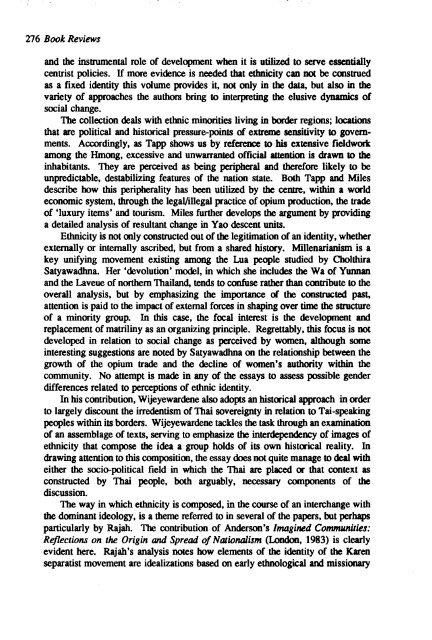1991 No. 1 CONTENTS - Institute of Social and Cultural ...
1991 No. 1 CONTENTS - Institute of Social and Cultural ...
1991 No. 1 CONTENTS - Institute of Social and Cultural ...
Create successful ePaper yourself
Turn your PDF publications into a flip-book with our unique Google optimized e-Paper software.
276 Book Reviews<br />
<strong>and</strong> the instrumental role <strong>of</strong> development when it is utilized to serve essentially<br />
centrist policies. If more evidence is needed that ethnicity can not be coostrued<br />
as a fixed identity this volume provides it, not only in the data, but also in the<br />
variety <strong>of</strong> approaches the authors bring to interpreting the elusive dynamics <strong>of</strong><br />
social change.<br />
The collection deals with ethnic minorities living in border regions; localions<br />
that are political <strong>and</strong> historical pressure-points <strong>of</strong> extreme sensitivity to governments.<br />
Accordingly, as Tapp shows us by reference to his extensive faeldwork<br />
among the Hmong, excessive <strong>and</strong> unwarranted <strong>of</strong>ficial attention is drawn to the<br />
inhabitants. They are perceived as being peripheral <strong>and</strong> therefore likely to be<br />
unpredictable, destabilizing features <strong>of</strong> the nation state. Both Tapp <strong>and</strong> Miles<br />
describe how this peripherality has been utilized by the centre, within a world<br />
economic system, through the legaVillegal practice <strong>of</strong> opium production, the trade<br />
<strong>of</strong> 'luxury items' <strong>and</strong> tourism. Miles further develops the argument by providing<br />
a detailed analysis <strong>of</strong> resultant change in Yao descent units. .<br />
Ethnicity is not only constructed out <strong>of</strong> the legitimation <strong>of</strong> an identity, whether<br />
externally or internally ascribed, but from a shared history. Millenarianism is a<br />
key unifying movement existing among the lAta people studied by Cholthira<br />
Satyawadhna. Her 'devolution' model, in which she includes the Wa <strong>of</strong> Yunnan<br />
<strong>and</strong> the Laveue <strong>of</strong> northern Thail<strong>and</strong>, tends to confuse rather than cmtribute to the<br />
overall analysis, but by emphasizing the importance <strong>of</strong> the constructed past,<br />
attention is paid to the impact <strong>of</strong> external forces in shaping over time the sttucture<br />
<strong>of</strong> a minority group. In this case, the focal interest is the development <strong>and</strong><br />
replacement <strong>of</strong> matriliny as an organizing principle. Regrettably, this focus is not<br />
developed in relation to social change as perceived by women, although some<br />
interesting suggestions are noted by Satyawadhna on the relationship between the<br />
growth <strong>of</strong> the opium trade <strong>and</strong> the decline <strong>of</strong> women's authority within the<br />
community. <strong>No</strong> attempt is made in any <strong>of</strong> the essays to assess possible gender<br />
differences related to perceptions <strong>of</strong> ethnic identity.<br />
In his contribution, Wijeyewardene also adopts an historical approach in order<br />
to largely discount the irredentism <strong>of</strong> Thai sovereignty in relation to Tai-speaking<br />
peoples within its borders. Wijeyewardene tackles the task through an examination<br />
<strong>of</strong> an assemblage <strong>of</strong> texts, serving to emphasize the interdependency <strong>of</strong> images <strong>of</strong><br />
ethnicity that compose the idea a group holds <strong>of</strong> its own historical reality. In<br />
drawing attention to this composition, the essay does not quite manage to deal with<br />
either the socio-political field in which the Thai are placed or that context as<br />
constructed by Thai people, both arguably, necessary components <strong>of</strong> the<br />
discussion.<br />
The way in which ethnicity is composed, in the course <strong>of</strong> an interchange with<br />
the dominant ideology, is a theme referred to in several <strong>of</strong> the papers, but perhaps<br />
particularly by Rajah. The contribution <strong>of</strong> Anderson's Imagined Communities:<br />
Reflections on the Origin <strong>and</strong> Spread <strong>of</strong> Nationalism (London, 1983) is clearly<br />
evident here. Rajah's analysis notes how elements <strong>of</strong> the identity <strong>of</strong> the Karen<br />
separatist movement are idealizations based on early ethnological <strong>and</strong> missionary
















